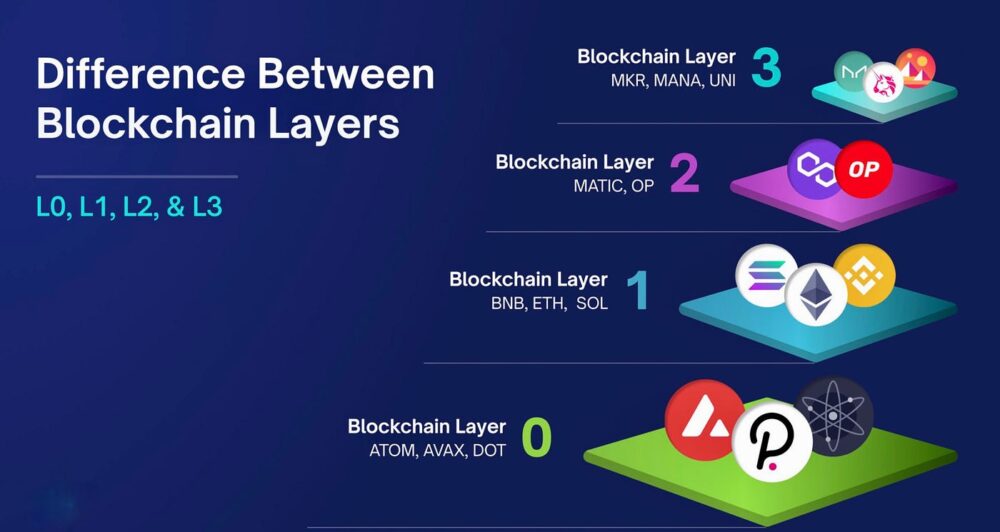If you’re new to Web3, you may hear terms like Layer 0, Layer 1, and Layer 2 thrown around in discussions about blockchain and crypto projects. Don’t worry – these are easier to understand than they sound. Let’s break them down with simple analogies and real-world examples to make your Web3 learning journey smoother.
What is Layer 0? The Foundation of Everything

Imagine you are building a city. Before you can build houses (blockchains) and roads (transactions), you need land and ground infrastructure where everything will stand. That’s what Layer 0 is in blockchain – the ground and foundation that supports everything above it.
Layer 0 is the underlying infrastructure that enables multiple blockchains to connect and communicate with each other. It usually consists of protocols and frameworks that support interoperability, allowing different Layer 1 blockchains to work together seamlessly.
Example:
- Polkadot: Polkadot’s Layer 0 framework, called Relay Chain, connects various independent blockchains called parachains, allowing them to share security and communicate efficiently.
- Cosmos: Cosmos uses Tendermint Core as Layer 0, connecting blockchains in its ecosystem through the Inter-Blockchain Communication (IBC) protocol.
What is Layer 1? The Main Blockchain Network

Back to our city example, Layer 1 is like the city itself with its rules, buildings, and residents. It has its own structure and security system. People can build shops, houses, and services directly in the city following its regulations.
Layer 1 refers to the main blockchain networks that operate independently. They provide security, consensus, and the ability to create decentralized applications (dApps) on top of them without needing other chains.
Example:
- Bitcoin: A classic Layer 1 blockchain used mainly for secure peer-to-peer transactions and store of value.
- Ethereum: A Layer 1 blockchain where developers can build smart contracts and dApps, such as DeFi protocols or NFT marketplaces.
- Solana: Another Layer 1 blockchain known for high-speed transactions with low fees.
What is Layer 2? The Helper for Scalability

Imagine the main city roads (Layer 1) become crowded with traffic. To reduce congestion, the government builds flyovers, tunnels, or subway lines. These do not replace the roads but help ease traffic by carrying part of the load. That’s what Layer 2 does for blockchain networks.
Layer 2 solutions are protocols built on top of Layer 1 blockchains to increase their scalability and reduce transaction fees without compromising security. They process transactions off the main chain and then report them back, allowing faster and cheaper operations.
Example:
- Polygon (Matic): A popular Layer 2 solution for Ethereum that enables faster transactions with lower fees, widely used by NFT and DeFi projects.
- Arbitrum & Optimism: Both are Layer 2 rollups for Ethereum that handle transactions off-chain and send the final results back to the Ethereum mainnet.
What is Layer 3? The Application Layer

Now imagine in your city there are shops, schools, hospitals, and entertainment venues that people actually use daily. These are built on top of the city infrastructure. In Web3, this is Layer 3.
Layer 3 is the application layer where developers build decentralized applications (dApps) and user-facing services that people interact with directly. It uses Layer 1 or Layer 2 as its base but focuses on creating real-world use cases and solutions.
Example:
- Uniswap: A decentralized exchange dApp built on Ethereum.
- Aave: A DeFi lending and borrowing platform built on Layer 1 and Layer 2 solutions.
- Decentraland: A virtual world dApp built on Ethereum allowing users to buy land and build experiences.
Here’s a quick summary

Understanding these layers helps you see the bigger picture of Web3 infrastructure:
- Layer 0: The foundational ground enabling different blockchains to connect.
- then Layer 1: The main blockchain networks with their own security and rules.
- Layer 2: Scalability solutions to reduce fees and speed up transactions.
- and last is Layer 3: The applications and dApps we use in the Web3 world.
Just like building a city needs land (Layer 0), city structures (Layer 1), flyovers or subways (Layer 2), and daily services (Layer 3), Web3 needs all these layers to function efficiently and grow seamlessly. Each layer plays an important role in making blockchain technology accessible, usable, and ready for mass adoption.
If you’re exploring blockchain investments, dApp development, or simply want to understand the technology behind the future of the internet, learning about Layers 0 to 3 is an excellent start.
If there’s something you want me to cover next, just let me know. You can follow me here on my website and my Medium to get my latest updates as soon as they drop! You can also contact me through X @AskaraJr and Linkedin



